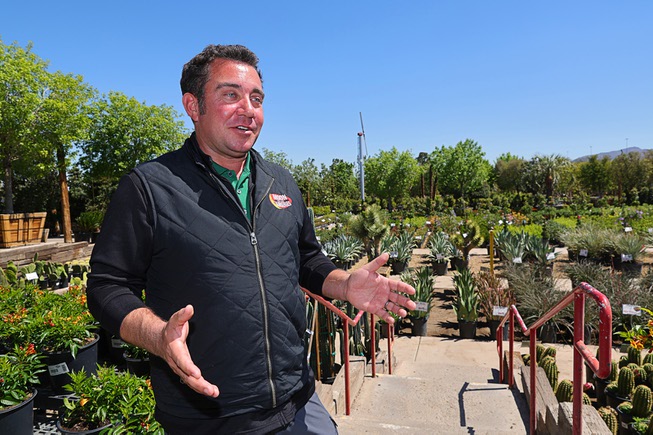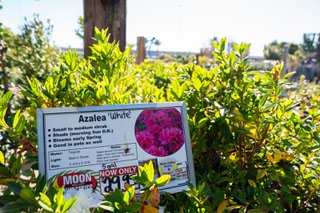
Matthew Fichera, Nevada regional manager for Moon Valley Nurseries, talks about landscaping during an interview at the Eastern Avenue location Wednesday, April 3, 2024.
Monday, April 22, 2024 | 2 a.m.
April is one of the busiest times of the year at Moon Valley Nurseries on Eastern Avenue, with residents eager to plant trees and bushes to take advantage of the warmer spring weather.
They are greeted at the entrance by two sets of plants — 10-foot bay laurel hedges and magnolia trees — attracting attention from homeowners looking for shade and privacy.
But only the bay laurels are recommended by the Southern Nevada Water Authority’s regional plant list because they thrive with limited watering.
The other takes too much water to keep alive and is not recommended by the water authority, whose list of suitable plants is part of the ongoing water conservation effort to manage the drought.
Matt Fichera, regional manager for Moon Valley Nurseries, said Southern Nevada’s climate allows for planting in both spring and fall, but spring brings the most customers to his stores.
“This time of year is very special because things are starting to flower,” Fichera said. “Even the cactus are starting to flower. They’re very happy.”
Customers looking for a desert landscape gravitate toward blue glow agave and barrel cacti, Fichera said, but those seeking shade trees might choose Chilean mesquite, Palo Verde and other “classic” desert trees that have just started to grow leaves.
“They’re going to go long periods of time without water and still stay strong and growing,” Fichera said.
But the nursery is also home to tipu trees, magnolias and other water-reliant displays the Southern Nevada Water Authority warns against.
Paul Noe, a horticultural expert for Star Nursery, was one of more than 20 local horticultural and agriculture experts the water authority assembled to help create its list of plants to avoid. Other members of the group included university officials, water authority staff, and forester leaders from local jurisdictions.
“It’s very extensive,” Noe said. “You can pick the attributes you want, and narrow it down to the plant that has the attributes you’re looking for.”
The group narrowed the list to plants that everyone agreed did the best in the semi-arid Southern Nevada climate, Noe said. The list spells out each plant’s characteristics, including its height and dimensions, whether it sheds leaves, flowers or seeds, and how much water it needs.
“You can grow almost anything if you put it in the right place and give it the right soil conditions and environment,” Noe said. “So there’s a lot of things that I have seen grown here that I would not recommend, unless they knew exactly what they were doing.”
Noe said drought-tolerant flowers range from butterfly bushes to desert birds of paradise in red and fellow varieties.
The Baja fairy duster comes in red and pink blooms, and lantana varieties come in red, yellow and purple. Rosemary is evergreen, but blooms with blue flowers. Desert miracles, bush morning glories, bush daisies and gaillardias all thrive as well.
“They’re very colorful through the hot, hot weather,” Noe said.
It’s important not to plant those flowers too close to cacti and succulents, since shrubs will require more water, Noe said.
He said trees like Palo Verde and desert willow all have lower water needs, but desert willows shed seed pods that some gardeners find annoying. Tree selections can also go wrong when builders don’t take a mature tree’s size into account when they landscape a new lawn, he said.
“It’ll look nice for several years, but they get to be a 40- or 50-foot tree and they’re going to overwhelm the front yard,” Noe said. “You have to be aware of how much room you actually have for the tree to mature.”
Fichera said he tells customers that Southern Nevada has three stages of summer that he treats like distinct seasons that require their own watering cycle. In his mind, 90 to 95 degrees is summer, 105 degrees and higher is “summer plus,” and 115 degrees and higher is “summer plus plus.”
Fichera said some landscapers set timers to water trees three times a day for 10 minutes, which trains roots to spread out instead of venturing deeper into the earth to develop stronger root systems.
Watering plants more heavily and deeply teaches roots to grow deeper to look for water, making plants stronger and more well-rooted in the ground over time, he said.
During hot weather, some homeowners make the mistake of hosing off their plants in an attempt to cool them. Instead, water droplets act like magnifying glasses for the sun’s rays, amplifying them and frying the leaves.
In winter, trees need water about one day a week, Fichera said.
“Winter is time for regrowth,” he said. “Your tree doesn’t look like it’s growing above ground, but that’s the time it’s (roots) are crawling for water and really growing.”
rhiannon.saegert@gmg vegas.com / 702-948-7836 / @musettasun

